Still a Lot Happening in Italy
Allies press toward Naples, which is reported to be burning
For those who enjoy reading expansive WW2 history books and ongoing, daily news reports about, for example, the Allied battle for steady advancement and ultimate control in Italy - a very tough slog - the study of microfilm re The Montreal Star would not be a waste of time, especially for Canadians, Americans and Brits.
News reports about the American 5th Army, the British 8th Army and (eventually) the Canadian Army steadily poured forth from The Med for weeks and months, during 1943 - mid-'45.
That being said, those readers (such as myself) interested in the Canadians in Combined Operations, news is sparce. There's a flood of news about Allied advances, ground gains and losses. But there's only an occasional drop about the members of the 80th Flotilla of Canadian Landing crafts toiling between Messina, Sicily and Reggio di Calabria (on Italy's toe of the boot), i.e., during the time span of my current research project re Sept. - Oct., 1943.
Members of RCNVR and Comb. Ops worked diligently during Operation Husky (invasion of Sicily beginning in early July, 1943). They were then sent to rest, recuperate and repair their landing crafts on Malta in August. They are still working tough shifts daily, faithfully supplying necessary troops and materials of war for the Allied push in Italy, during September and October, '43.
The majority of posts related to my current research of The Montreal Star (to track down the Star war correspondent who accompanied the 80th Flotilla on one of their runs; to locate any articles about such a run), contain a steady flood of news about about various war fronts, including articles, editorial cartoons and ads that supply readers with some knowledge of the times when a wee slice of the Canadian Navy Volunteer Reserve was attempting to support Allied troops in Italy.
It would be a long time before vacationers returned
to the lovely tourist regions near or in Naples
While Canadians in Combined Operations transported men and supplies, members of the RAF and RCAF delivered devastation to Hanover, "into enemy Europe":
Photographs found in The Star continue to be grainy (as do captions and accompanying articles) but we can still pick up a bit of a glimpse re what was going on at this time in Italy, i.e., late September, 1943. Below we see a Canadian Army Captain taking "over the depot (and garrison headquarters) from the Italian commander":
Canadians in Combined Ops did get some time off during this time and visited some of the stores and depots in order to purchase items of interest (souvenirs). Doug Harrison writes:
We had some days off and we travelled, did some sight seeing, e.g., visiting German graves. We met Sicilian prisoners walking home disconsolately, stopped them, and took sidearms from any officer. We saw oxen still being used as draft animals when we were there. Sometimes we went to Italy and to Allied Military Government of Occupied Territory (AMGOT). (They later changed that name because in Italian it meant sh--!)
While a couple of ratings kept the man in charge of all the revolvers busy, we picked out a lot of dandies. If he caught us we were ready. We had chits made out, i.e., “Please supply this rating with sidearms,” signed Captain P. T. Gear or Captain B. M. Lever, after the Breech Mechanism Lever on a large gun.
Editor's note: My father's memory was very good almost to the end of his days. However, Operation Baytown, in which he took part (and writes about), began on September 3, 1943. Dad later writes about celebrating his birthday a few days later while housed in Sicily, after the invasion of Italy.
More news from The Montreal Star to lend a bit of flavour to the times:
I include the following photo, though of poor quality, because it depicts a transportation system - re war materiel - that is about another type of the power needed to supply troops, i.e., 'mule power' vs man power and landing crafts:
Hats off to a "big American field hospital" (mentioned above) for delivering an Italian woman's baby in dire circumstances. While reading the news article from The Star I recalled a few lines from my father's memoirs:
Setting - Messina, Sicily (the departure point for men and supplies to Italy)
Time Line - Same as above, approximately
Topic - Same as above, approximately : )
Dad writes:
There was no resistance (re Operation Baytown, invasion of Italy on Sept. 3, 1943).
Page 37, "Dad, Well Done"
Allied forces had their hands full as they tried to gain ground in southern Italy:
Canadian war correspondent Ross Munro, who also travelled aboard Canadian landing crafts at times, writes about some men who received awards for their actions while in Sicily. The report below was written in August (28th) but appears about four weeks later in the Sept. 23 issue of The Star.
Because of these occasional delays, I have come to think that my writer of interest, Sholto Watt, may be writing about his experiences as well but not getting articles posted on or very near the date of writing. So my search may have to be extended into mid-late October even though the Canadians of the 80th Flotilla left Sicily/Italy in early October.
From Ross Munro:
The map below provides the dates when several events began, including Sept. 3 for the invasion of Reggio Calabria, aka Operation Baytown, which included the 80th Flotilla of Canadian Landing Crafts. Also seen is the Sept. 9 date for the invasion of Salerno, aka Operation Avalanche, fiercely contested.
In Hal Boyle's article below - a detailed eyewitness account - he describes landing on beaches south of Salerno in what I feel was not an LCM (used by the 80th Canadian Flotilla) but one of the following: a Landing Craft, Tank (LCT), Landing Ship, Tank (LST), or an Infantry, Large (LCI (L)), large enough for a ward room and bunks, and with a flat bottom, in part for some. These types of landing craft were used aplenty during the invasion of Normandy in June, 1944:
Canadian in Combined Ops were sent to Malta after their work associated with the invasion of Sicily was completed in early August. Some, like my father, needed medical care because of dysentery, an intestinal problem that seemed to hit just a lot of men. Others received time to rest and read mail, some were instructed to get busy and make repairs to landing crafts needed for the next operation, i.e., the invasion of Italy in September.
Here is part of what my father recalls:
After approximately 27 days (in Sicily) I came down with severe chills and then got dysentery. I was shipped to Malta on the Ulster Monarch and an intern came around and handed me 26 pills. I inquired how many doses was that? “Just one,” he replied. At Malta I was let loose on my own to find Hill 10 Hospital. I did after a while and they asked me my trouble.
Allied forces had their hands full as they tried to gain ground in southern Italy:
Canadian war correspondent Ross Munro, who also travelled aboard Canadian landing crafts at times, writes about some men who received awards for their actions while in Sicily. The report below was written in August (28th) but appears about four weeks later in the Sept. 23 issue of The Star.
Because of these occasional delays, I have come to think that my writer of interest, Sholto Watt, may be writing about his experiences as well but not getting articles posted on or very near the date of writing. So my search may have to be extended into mid-late October even though the Canadians of the 80th Flotilla left Sicily/Italy in early October.
From Ross Munro:
The font size on the italics print above is very small and gets no clearer with enlargement capabilities on my computer. It reads - "Four weeks ago Ross Munro cabled the following story on decorations won by officers and men of the 1st Canadian Division in the Sicilian campaign. The story could not be released pending official announcement by National Defence Headquarters in Ottawa of the full list. In the meantime several names of those decorated became known through letters to relatives."
The map below provides the dates when several events began, including Sept. 3 for the invasion of Reggio Calabria, aka Operation Baytown, which included the 80th Flotilla of Canadian Landing Crafts. Also seen is the Sept. 9 date for the invasion of Salerno, aka Operation Avalanche, fiercely contested.
In Hal Boyle's article below - a detailed eyewitness account - he describes landing on beaches south of Salerno in what I feel was not an LCM (used by the 80th Canadian Flotilla) but one of the following: a Landing Craft, Tank (LCT), Landing Ship, Tank (LST), or an Infantry, Large (LCI (L)), large enough for a ward room and bunks, and with a flat bottom, in part for some. These types of landing craft were used aplenty during the invasion of Normandy in June, 1944:
Here is part of what my father recalls:
After approximately 27 days (in Sicily) I came down with severe chills and then got dysentery. I was shipped to Malta on the Ulster Monarch and an intern came around and handed me 26 pills. I inquired how many doses was that? “Just one,” he replied. At Malta I was let loose on my own to find Hill 10 Hospital. I did after a while and they asked me my trouble.
I said, “Dysentery.”
“Oh, we’ll soon cure that,” they said.
How? “We won’t give you anything to eat.”
So for four days all I got was water and pills and soon I was cured, though weak. I thought of those poor devils in the desert.
When I felt better they sent me to a tent where I got regular meals. I saw an air force newspaper and on the front was a picture of Bob Alexander of Norwich, a school chum. But Bob returned to the fray and was lost on one of his bombing missions. How sorry I was to hear that news. He had already done so much.
Soon all the boys returned to Malta and we prepared for Italy, though all our barges stayed in Sicily.
When I felt better they sent me to a tent where I got regular meals. I saw an air force newspaper and on the front was a picture of Bob Alexander of Norwich, a school chum. But Bob returned to the fray and was lost on one of his bombing missions. How sorry I was to hear that news. He had already done so much.
Soon all the boys returned to Malta and we prepared for Italy, though all our barges stayed in Sicily.
Editor's note: Many Canadian barges had to be repaired after hard use in Sicily, but the 81st Flotilla was not required (learned later) for the Italian invasion.
My father continues:
We took a Landing Ship Tank (LST) back to Mila Marina, Sicily and, if memory serves me correctly, attacked Italy at Reggio Calabria across Messina Straits on my birthday, September 6, 1943.
Editor's note: My father's memory was very good almost to the end of his days. However, Operation Baytown, in which he took part (and writes about), began on September 3, 1943. Dad later writes about celebrating his birthday a few days later while housed in Sicily, after the invasion of Italy.
More news from The Montreal Star to lend a bit of flavour to the times:
Photo Credit for U.S. war poster - The Boston Library System
I include the following photo, though of poor quality, because it depicts a transportation system - re war materiel - that is about another type of the power needed to supply troops, i.e., 'mule power' vs man power and landing crafts:
Hats off to a "big American field hospital" (mentioned above) for delivering an Italian woman's baby in dire circumstances. While reading the news article from The Star I recalled a few lines from my father's memoirs:
Setting - Messina, Sicily (the departure point for men and supplies to Italy)
Time Line - Same as above, approximately
Topic - Same as above, approximately : )
Dad writes:
There was no resistance (re Operation Baytown, invasion of Italy on Sept. 3, 1943).
The air force had done a complete job and there wasn’t a whole building standing and the railroad yards were ripped to shreds. How long we worked across the straits I cannot really recall, but perhaps into October. One of our stokers set up a medical tent for the civilians at Messina and treated them for sores and rashes. We fed them too but when pregnant women came we had to close up shop.
Page 37, "Dad, Well Done"
Thumbs up for "Made in Canada, WW2":
Other items of interest - at least to the Editor of 1,000 Men - from The Montreal Star on Sept. 24, 1943:
The Tirpitz, Germany's largest battleship, is the subject of several very readable books. It was eventually sunk by Allied forces and many would say, "Well done!"
The Allied raid on St. Nazaire in France in the spring of 1942 (the earliest raid, I believe, in which Canadians were involved), a few months before before the Dieppe raid, was connected to the Tirpitz.
Monty was right:
Books about the battle for Stalingrad are gripping. Perhaps copies of the film mentioned below still exist. I will see what Mr. Google has to say.
Mr. Google says, "Check out YouTube." https://www.youtube.com/watch?v=yRS4jdbhW3s
Page 37, "Dad, Well Done"
Thumbs up for "Made in Canada, WW2":
Other items of interest - at least to the Editor of 1,000 Men - from The Montreal Star on Sept. 24, 1943:
The Tirpitz, Germany's largest battleship, is the subject of several very readable books. It was eventually sunk by Allied forces and many would say, "Well done!"
The Allied raid on St. Nazaire in France in the spring of 1942 (the earliest raid, I believe, in which Canadians were involved), a few months before before the Dieppe raid, was connected to the Tirpitz.
Monty was right:
Books about the battle for Stalingrad are gripping. Perhaps copies of the film mentioned below still exist. I will see what Mr. Google has to say.
Mr. Google says, "Check out YouTube." https://www.youtube.com/watch?v=yRS4jdbhW3s
More news from Sholto Watt and Scott Young to follow.
Unattributed Photos GH
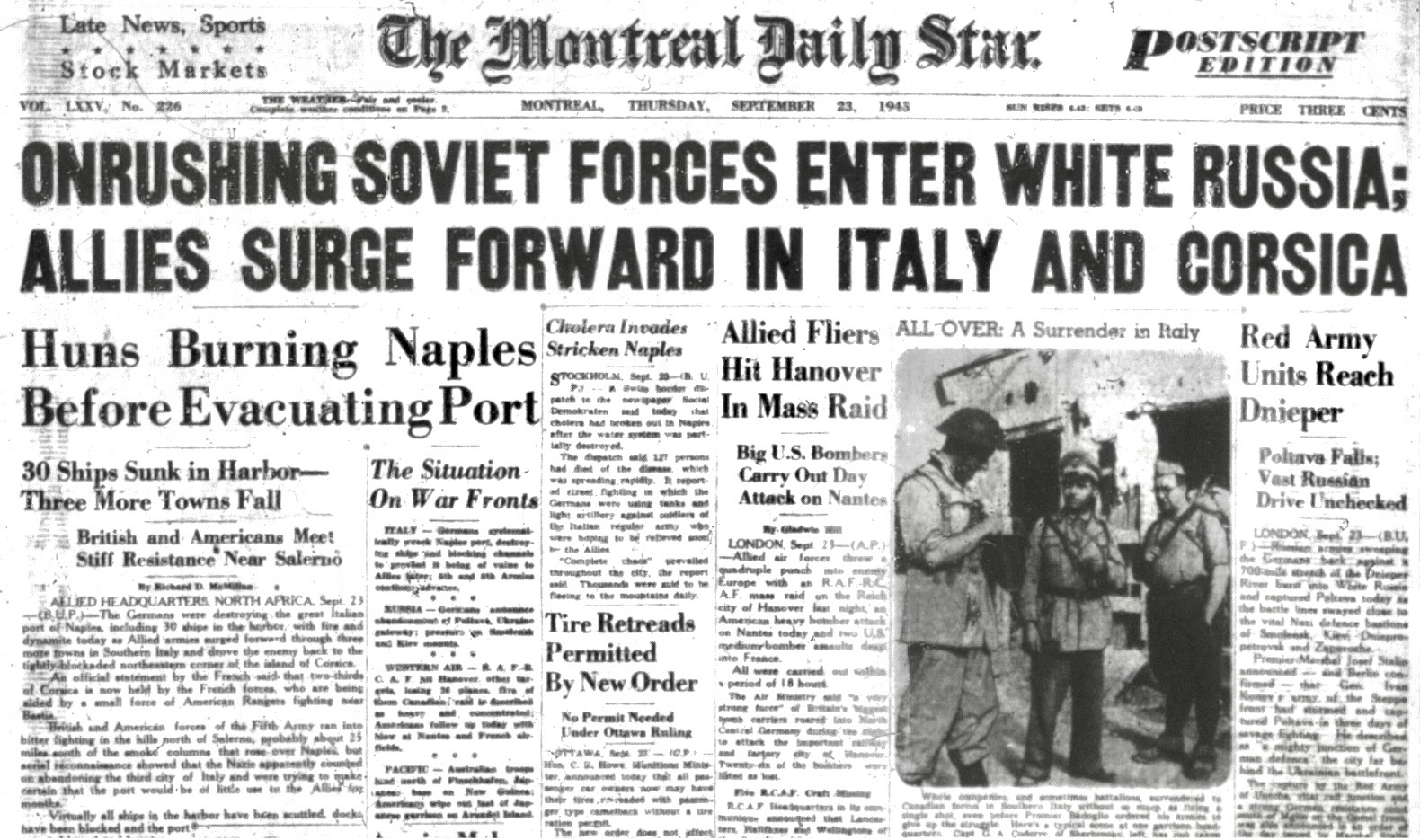




















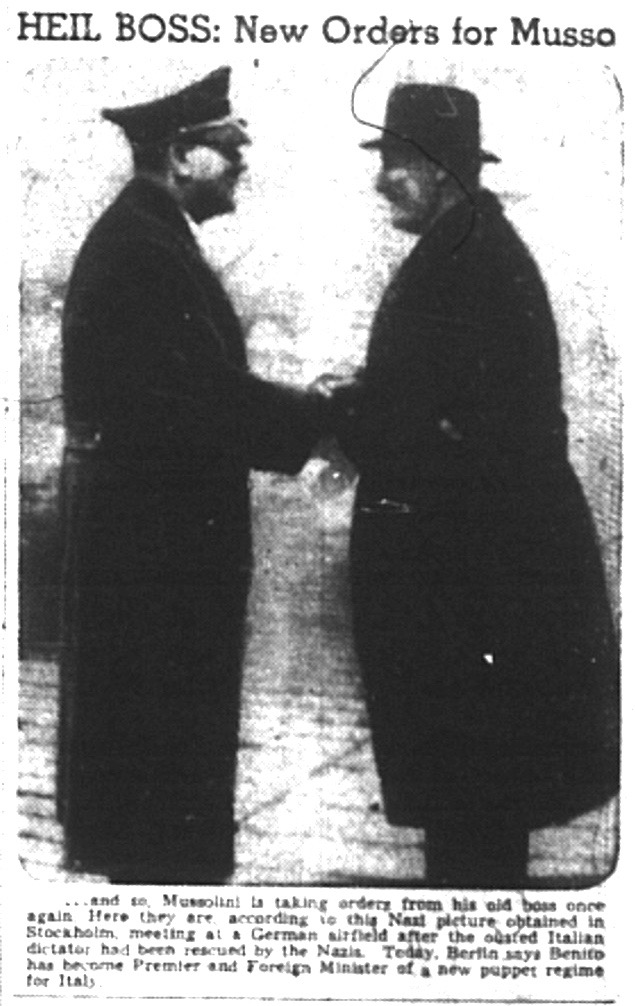













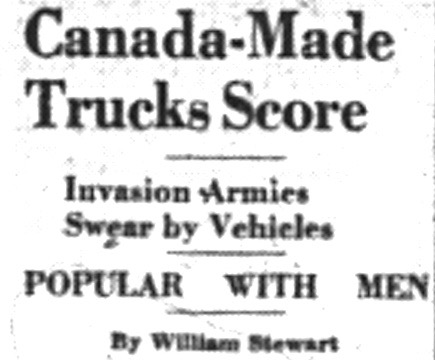
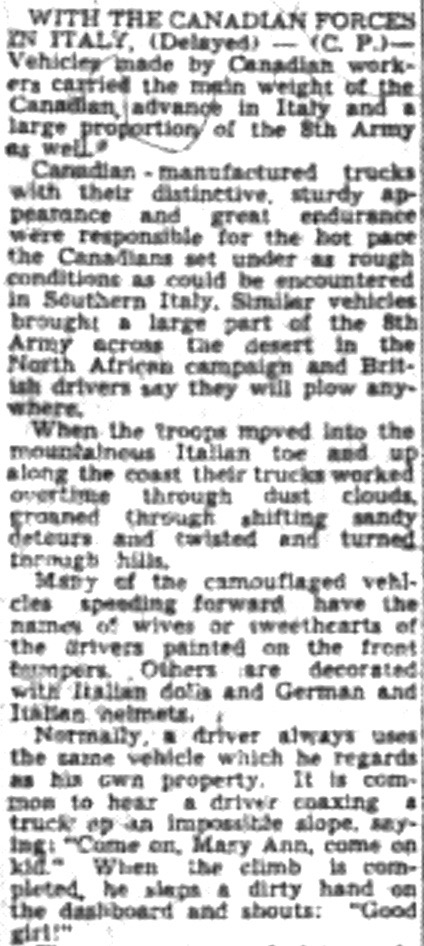

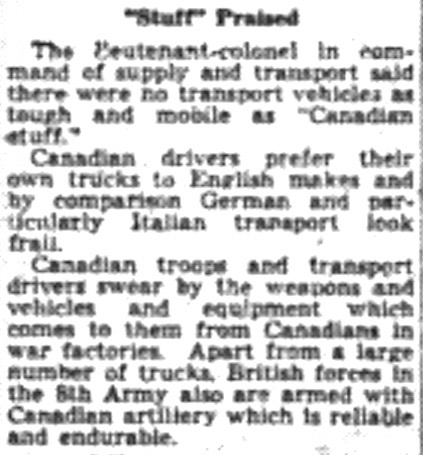











No comments:
Post a Comment